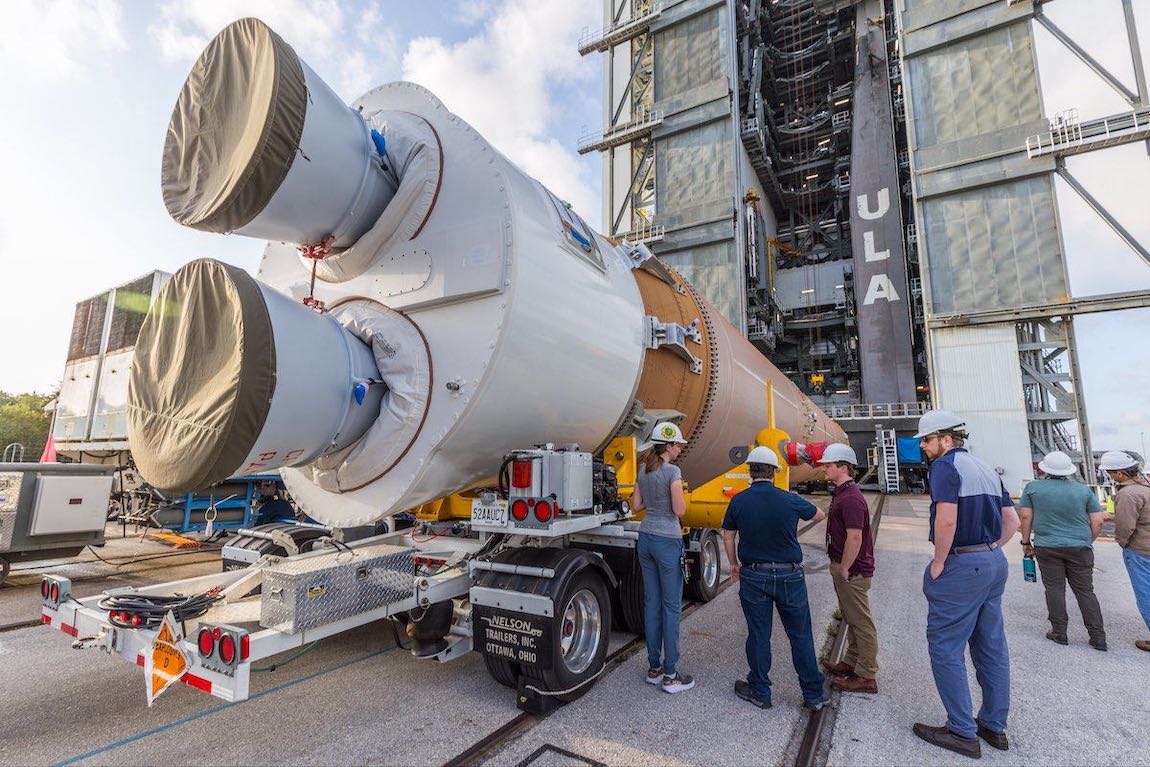
Final assembly of a United Launch Alliance Atlas 5 rocket began Wednesday with the hoisting of a first stage booster onto a mobile launch platform at Cape Canaveral, kicking off a campaign to prepare for liftoff May 19 on a delayed unpiloted test flight of Boeing’s Starliner crew capsule.
ULA’s ground team raised the Atlas first stage off its trailer transporter, and a crane lifted the rocket into the Vertical Integration Facility Wednesday morning. The 107-foot-tall (33-meter) rocket stage was then lowered onto the Atlas 5’s mobile launch platform inside the integration building just south of ULA’s launch pad at Space Launch Complex 41.
The milestone event Wednesday, known as Launch Vehicle On Stand, will be followed in the coming days by the addition of two strap-on AJ-60A solid rocket boosters made by Aerojet Rocketdyne. Then a dual-engine Centaur upper stage will be raised on top of the Atlas first stage to complete the initial build-up of the launcher.
In early May, Boeing and ULA will move the Starliner spacecraft from its hangar at the Kennedy Space Center to the VIF for stacking atop the Atlas 5.
The launch preparations will culminate in rollout of the Atlas 5 rocket and Starliner spacecraft to pad 41 on May 18. Liftoff to begin Boeing’s Orbital Flight Test 2 mission to the International Space Station is scheduled for 6:54 p.m. EDT (2254 GMT).
The mission is scheduled to last approximately one week, with docking at the space station scheduled the day after liftoff. The Starliner capsule will return to Earth for a parachute-assisted, airbag-cushioned landing at one of Boeing’s recovery sites in the Western United States.

The Starliner demo, known as OFT-2, mission is a redo of an unpiloted test flight in December 2019 cut short by software problems. The software issues prevented the spacecraft from docking with the International Space Station, and the capsule safely landed in New Mexico after an abbreviated mission.
After several hardware and software changes, Boeing readied for second attempt at the Starliner’s Orbital Flight Test mission — designated OFT-2 — last August. The spacecraft was rolled to the launch pad at Cape Canaveral atop its Atlas 5 rocket, but tests revealed stuck valves in the Starliner propulsion system.
Boeing and NASA, which manages the Starliner commercial crew contract, agreed to remove the Starliner from the Atlas 5 rocket and postpone the mission to investigate the valve problem. Engineers believe the valve components likely corroded from the interaction of nitrogen tetroxide propellant with moisture that seeped into the thrusters on the spacecraft’s service module, then permeated a Teflon seal inside the valve itself.
Technicians removed the service module from the Starliner’s crew module in January for shipment to a test facility in New Mexico, where teams are performing tests to better understand the valve problem. The OFT-2 mission will fly with a new service module, one originally assigned to the first Starliner mission with astronauts.
Teams inside Boeing’s Starliner hangar mated the crew module with the new service module March 12. Filling of the service module with propellant is expected to occur this month, before the spacecraft rolls over to ULA’s rocket integration building for stacking atop the Atlas 5.
Boeing said the Starliner team designed a new purging system to help prevent moisture from getting into the valves during the upcoming launch campaign while the spacecraft is in the factory and at ULA’s launch site.

If successful, the OFT-2 mission will pave the way for Starliner’s Crew Flight Test, which will carry a team of three NASA astronauts to the space station. That will ultimately lead to operational crew rotation flights on the Starliner spacecraft, akin to SpaceX’s Crew Dragon missions to the space station, giving NASA two U.S. vehicles capable of ferrying astronauts to and from the orbiting research complex.
Following the grounding of the OFT-2 last year, ULA removed the Atlas 5 rocket’s dual-engine Centaur stage and solid rocket boosters, but kept the launcher’s core stage in position on its mobile platform. Ground teams added a different version of the Centaur upper stage for the launch of NASA’s Lucy asteroid explorer last October.
The solid rocket boosters and dual-engine Centaur upper stage were kept in storage for the last eight months until Boeing engineers could ready the Starliner spacecraft for another launch campaign.
A new Atlas first stage was delivered to Cape Canaveral last week from ULA’s factory in Decatur, Alabama, on NASA’s Pegasus rocket barge, a vessel originally built to ferry space shuttle external tanks between their manufacturing site in New Orleans and the Kennedy Space Center.
Since the retirement of the shuttle, the Pegasus barge has been modified to carry the core stage of NASA’s Space Launch System moon rocket. ULA’s rocket ferry, named the R/S RocketShip, is currently in a routine dry dock period and river locks on the typical route from Decatur to Cape Canaveral are closed for maintenance, ULA said.
On previous occasions when the RocketShip vessel was unavailable, ULA has used Ukrainian-built Antonov An-124 cargo planes to fly Atlas booster stages from Alabama to the launch site. Those aircraft are operated by Russia’s Volga-Dnepr Airlines. Russian aircraft are banned from U.S. airspace in the aftermath of Russia’s military invasion of Ukraine.
Without the Antonov cargo planes, ULA turned to NASA to use its rocket barge to deliver the Atlas first stage to Cape Canaveral and keep the Starliner’s OFT-2 mission on track for launch in May.
Email the author.
Follow Stephen Clark on Twitter: @StephenClark1.
from Spaceflight Now https://ift.tt/36iOYlH
via World Space Info







0 comments:
Post a Comment